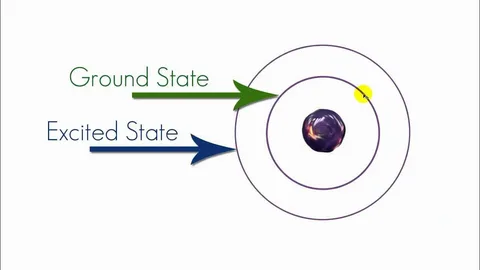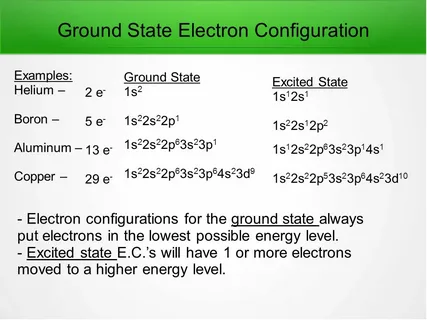The Importance of Ground State Electron Configuration in Predicting Chemical Behavior
From the atoms that fuel the chemical reactions of burning wood to the ones that bring life to the myriads of applications of charging your phone, atoms may be the tiniest particles of nature, but they seem to hold the secrets to how everything works. At the core of atomic behavior sits the idea of microstates, which helps physicists and chemists make sense of why certain reactions happen by aiding them in explaining how electrons are arranged in an atom.
In the current article, you will learn what the ground state of an electron is and the processes and steps outlined to determine electron configuration for both atoms and ions and how it differs from an excited state. Let us now turn towards the basics.

What is ground state and excited state?
As previously stated, electrons exist in energy levels or shells and are arranged around a central nucleus which forms a vital component of an atom. Loveable as they are, electrons come in pairs as they travel, and the ground state describes when all the electrons in an atom attain the most stable, energy efficient, and natural arrangement of the lowest possible energy levels.
The excited state describes having one or several electrons that have absorbed energy and as a result of this addition, have jumped to a higher energy level. The excited state is however not permanent, and when the electron returns to a lower level, energy is released in most cases as light.
Example:
- Ground state: An electron is sitting in the 2s orbital.
- Excited state: It soaks up energy and moves to the 2p sublevel.
What is the ground state of an electron?
An electron’s ground state describes its lowest possible energy state, which corresponds to the least energy arrangement in an atom. In this state, the electron occupies the orbital that is nearest to the nucleus until an external energy forces it to a higher level, promoting it to a different shell. This arrangement abides by a set of predefined boundaries for electron distribution aimed at maximizing the atom’s stability and neutrality.
What is the meaning of 1s, 2s, 2p, 3s, 3p?
Orbitals are subdivisions of energy levels, denoted by these symbols, where the electrons are located.
- 1s: The s-orbital within the first level (can fit 2 electrons).
- 2s and 2p: The second level has one s and three p orbitals (can fit 8 electrons).
- 3s and 3p: The number continues for the third level.
Each letter (s, p, d, f) denotes the shape of the orbitals and indicates the maximum number of electrons that may be contained:
- s → 2 electrons
- p → 6 electrons
- d → 10 electrons
- f → 14 electrons
The numbers (1, 2, 3…) indicate the principal energy levels or the shell number.
What is the strategy for determining the ground state electronic configuration?
Determining an atom’s electronic configuration involves the following:
- Identify the atomic number. The atomic number is the number of electrons in a neutral atom.
- The Aufbau principle dictates that orbitals are filled starting from the lowest available energy level.
What is the rule for electron shells in ground state?
The following order of the orbitals should also be obeyed:
- Apply the Pauli exclusion principle which states that no more than two electrons can occupy a single orbital.
- Following the previous point, apply Hund’s rule which states that for p, d, and f orbitals, electrons must fill all vacant orbitals before they can be paired.
As an example consider:
- Carbon has atomic number 6.
- It follows configuration: 1s² 2s² 2p².
Which element has the ground state electron configuration 1s² 2s² 2p⁶ 3s² 3p⁶?
This would be Argon (Ar).
- We have 18 total electrons alongside the atomic number Argon.
- So, with these facts; we can conclude that the element is Argon, a noble gas.
What is the suitable process to find the ground-state electron configuration of an ion?
To figure out the configuration of an ion:
- Start with the neutral atom’s ground state configuration.
- Use the ionic charge to calculate the addition or removal of electrons:
- Remove electrons from the outermost shell first for cations (positive ions).
- Anions (negative ions): Accept electrons to the subsequent available orbital.
Example:
- Sodium (Na) has an atomic number 11.
- Neutral: 1s² 2s² 2p⁶ 3s¹
- Na+ (loses one electron): 1s² 2s² 2p⁶
What is rule for electron shells in terms of ground state?
Electrons in the ground state fill lower orbitals first in energy order according to:
- Aufbau Principle
- Pauli Exclusion Principle
- Hund’s Rule
In this case, the atom achieves stability. Therefore, orbitals cannot be filled randomly but there is a certain order in which energy determines the sequence.
What is the mechanism in order to reach ground state from excited state?
Excited state corresponds to an atom where an electron has been promoted to a higher orbital using energy. In ground state, the atom has:
- Reverted the energy, in most cases light (photons)
- Returned to a lower position on the energy scale
This happens frequently in phenomena relating to the emission of light such as fluorescence and is critical in relation to the functioning of lasers and LEDs.
Is ground state n-1 or n 0?
This question mixes notations. In quantum mechanics, n stands for the principal quantum number, representing the main energy level.
- In this case, ground state refers to the lowest energy level set as (n=1).
- In this setting, there is no ‘n=0’.
- For electrons, the floor or ground state lies at n=1, unless we are talking about the sublevels; for example, in d orbitals, n-1 is important.
What is the ground state electron configuration for I (Iodine)?
Iodine is associated with atomic number 53, meaning it has 53 electrons in a neutral ground state.
Ground state configuration of Iodine (I):
- 1s² 2s² 2p⁶ 3s² 3p⁶ 4s² 3d¹⁰ 4p⁶ 5s² 4d¹⁰ 5p⁵
It can also be written in shorthand I as follows, using noble gas notation:
- [Kr] 5s² 4d¹⁰ 5p⁵.
The noble gas Kr (Krypton) is referenced in the shorthand as a substitute for the full configuration. Hence the notation used above.
Why ground state configurations are important?
The order of electrons for ground state is critical as it helps predict:
- Where on the Periodic Table they will be located
- What type of bonds they will form
- What type of elements they will react with.
For example:
- Elements with halogens gain electrons and those with alkali metals tend to lose them.
- All of chemistry is based upon this fundamental knowledge.
Electron configurations and light
As an atom is excited, the electrons within can jump between energy levels. In the process, specific wavelengths of light are emitted. This process enables the creation of:
- Neon lights
- Spectroscopy (in chemistry labs for chemical analysis)
- Fireworks colours
- Different elements emit different colors based on their electron transitions.
Final thoughts on ground state electron configuration
The ground state electron configuration of an atom is more than a mere enumeration of numbers and letters. It encapsulates how the atom behaves. The elemental centerpiece of the understanding is knowing the difference between ground and excited states, how one calculates the configuration of atoms and ions, and how orbitals like 1s, 2s, 2p, 3s, and 3p function is fundamentally important to core atomic structure.
All of this enables a keen understanding of the periodic table, offers insightful prognostications on chemical reactions, and nourishes the appreciation of the deeply elegant architecture that undergirds the matter’s minutest constituents.




Post Comment